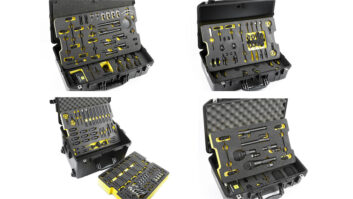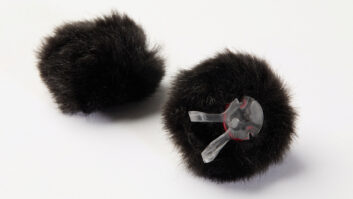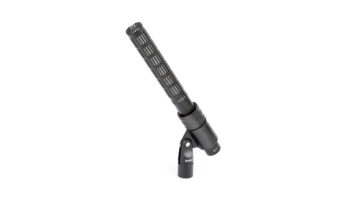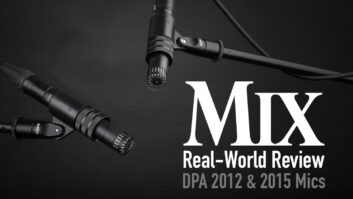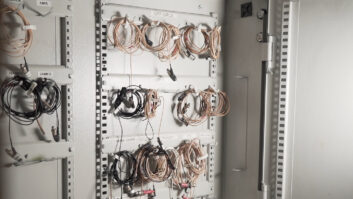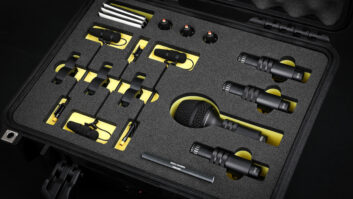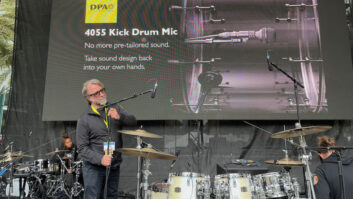The newest addition to DPA’s 4000 Series is the 4015 ($1,850). DPA
calls this mic a wide cardioid, and, indeed, between 500 Hz and 10k Hz,
the 4015’s polar response begins to resemble an omni mic. I was excited
about the possibilities of this added coverage, especially in
reverberant spaces to capture room ambience but with greater
directionality than an omni.
The 4015 uses the same pre-polarized, pressure-gradient condenser
capsule as DPA’s venerable 4011, but with a wider polar pattern. And like the 4011, the 4015 needs
48 volts of phantom power. It has a frequency range of 40
(±2 dB) to 20k Hz (+3/-1 dB) measured at two feet from
a sound source. The 4015’s response is relatively flat from 100 to 5k
Hz. From there, the mic offers a gentle high-end boost that peaks at
2.5 dB at 11 or 12 kHz, before descending to 0 dB again at roughly 18
kHz.
Despite DPA’s modest claims about the mic’s low-frequency
sensitivity, the 4015 easily handled the lowest lows of a church organ
while flawlessly capturing the high sparkle of its zimbelstern. I
reviewed an unmatched pair of 4015s, and their individual calibration
charts noted that the low-end response tapered gradually upward in
level (1 to 2 dB at 20 Hz, respectively). No complaints here.
The 4015’s capsule is 3/4 of an inch in diameter. The diaphragm is
surrounded by an acoustically transparent netting that protects against
contamination from dust. DPA claims the 4015’s diaphragm is built to
handle “aggressive” humidity and that the distance between
the back plate and diaphragm helps deter the influences of ambient
temperature. These specs appealed to me, because much of my recording
is done on location, often in drafty and damp churches and cathedrals.
Additionally, the mic handles high SPLs—up to an impressive 158
dB.
Remarkably, the 4015 includes a 20dB pad switch in the center of the
XLR connector, so you’ll need a small, pointed
object to get to it. You won’t switch the pad accidentally. No matter
what instrument I recorded, I never needed the pad.
The dynamic range of the 4015 is excellent, and the mic has a
wonderful multidimensionality. This is possibly due to the fact that
the on-axis directionality of the polar pattern narrows sharply above
10 kHz. Recordings with these mics always sounded clean and
transparent.
As drum overheads, the 4015 was great: The wide pattern captured the
surrounding drums and the cymbals, yielding a smooth, natural sound.
The 4015’s transient response is also superb: A recording session with
a nylon-string guitar demonstrated this. The guitarist wanted to track
the sound of the guitar’s piezo bridge pickup and the acoustic sound
simultaneously. I pointed one 4015 at the spot between the sound hole
and bridge, where this instrument had its fullest sound. On the amp, I placed the other 4015 between its four
speakers from a distance of 18 inches. Blending the two signals, I
captured the full snap of the strings, but with plenty of the
instrument’s meaty resonance and body.
I took full advantage of the 4015’s wide polar pattern when
recording a bass koto. I placed one of the mics under the instrument,
pointing directly into the sound hole; the other mic was three feet
above, aiming across the movable bridges. The extended pattern of the
upper mic captured most of the stringed area, yielding the instrument’s
characteristic pluckiness and a nice amount of the room. Meanwhile, the
lower mic accurately translated the warm tone emanating from inside the
koto.
The DPA 4015’s wide pattern provides a welcome intermediate
alternative to omnis and so-called first-order cardioids. The 4015 is
also durable and well-built: No matter where I recorded, I never felt
compelled to baby it. This is a first-rate transducer that brings out the best in almost any
audio source.
DPA Microphones, www.dpamicrophones.com
